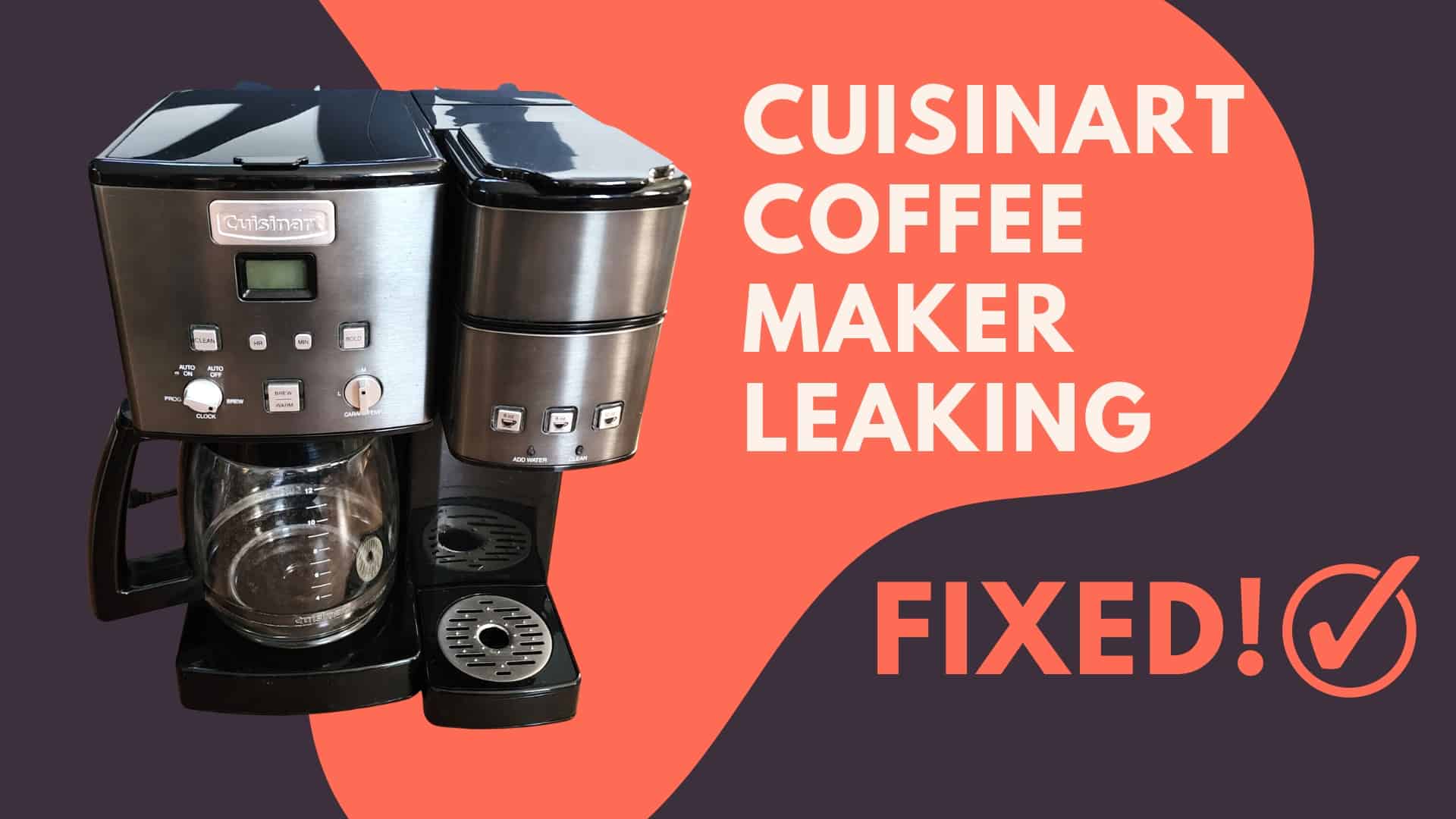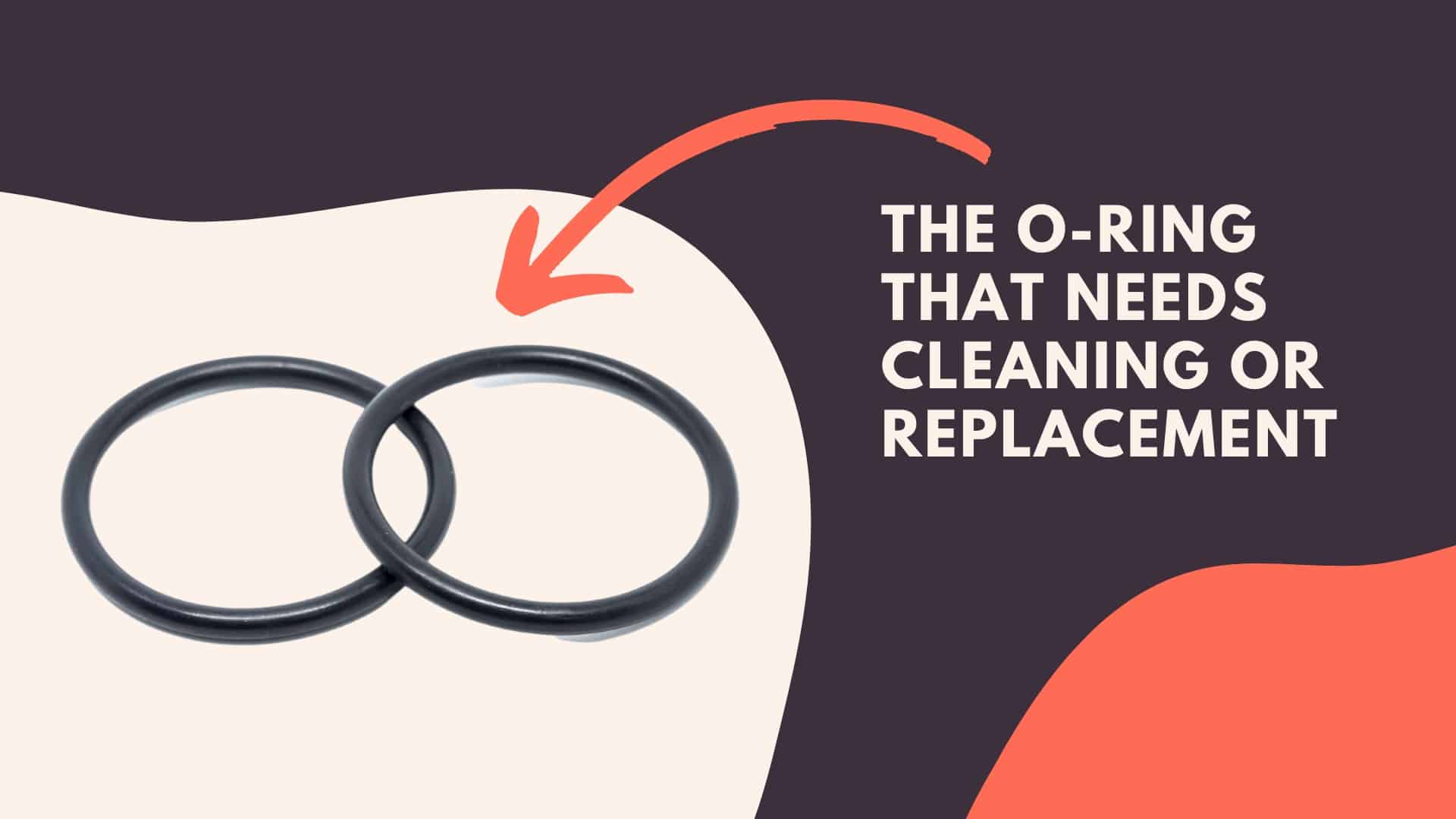Is your Cuisinart coffee maker leaking and disrupting your morning routine? No need to worry!
This guide will walk you through the common causes of these leaks and provide simple, effective solutions to get your machine back to brewing that perfect cup of coffee.
How To Fix A Cuisinart Coffee Maker That Is Leaking?
There are a few things that you can do:
- If it’s leaking from the bottom, clean or replace the O-ring in the water suction port.
- Regularly descale the machine to prevent residue build-up.
- For leaks from the carafe side, adjust the coffee amount/grind or check the filter spring.
- If the carafe leaks when pouring, ensure the lid is tight or consider a replacement.
- For leaks from the capsule side, clean the needle or assist in piercing the capsule.
Let’s dive into some more detail below!

My Cuisinart Coffee Maker Is Leaking From The Bottom
When your Cuisinart coffee maker begins to leak water from the bottom, it’s a clear sign that some maintenance is required. Often, the source of this leak is the water suction port and, more specifically, the O-ring within this port.
This section of the article will provide a step-by-step guide on how to handle a leaking issue from the bottom, focusing on how to clean or replace the O-ring and offering additional tips to further prevent leaks.
Clean Or Replace The O-Ring In The Water Suction Port
First, make sure your coffee maker is off and unplugged. Take off the water container, and if there are any filters, take those out too.
There’s a small hole where the water container was. This hole is where the coffee maker gets its water (it’s called the water suction port). This hole has a rubber ring called an O-ring that makes sure the water doesn’t leak out.
If there is any dirt or small bits around the O-ring or in the hole, it might stop the O-ring from making a good seal.
Clean The O-Ring
To clean the O-ring and the port, get a clean cloth or sponge that won’t scratch anything. Soak it in vinegar. Gently wipe the O-ring and the hole with the vinegar-soaked cloth or sponge. Let it sit for about half an hour.
Next, pour some water into the hole to wash away most of the vinegar. Put the water tank back in its place, and make a 10 oz cup to clean out any remaining vinegar.
Replace The O-Ring
If this O-ring is damaged or missing, it can also result in leaking.
Check if the O-ring is damaged or worn out because even a small crack in the O-ring can make water leak out. If the O-ring is damaged or missing, you’ll need a replacement. You can order a replacement O-ring from Amazon. Once you get the new O-ring, put it where the old one used to be.
If it’s not damaged or missing, check if it’s properly seated in its groove. If it’s not seated properly, this could be causing the leak. If the O-ring is out of place, remove it and clean the groove with a soft cloth. Then put the O-ring back, making sure it fits tightly and evenly all the way around.

Use Some Electrical Tape
If your coffee maker is leaking, using electrical tape around the bottom part of the water reservoir could help for a little while. Combined with the O-ring, this makes a really tight seal to keep water from getting out.
It’s important to note, this is a quick fix and it’s not going to last forever.
Here’s an easy guide on how you can do it:
- First, be sure the area is totally dry before you put on the tape. If there’s water or it’s damp, the tape won’t stick very well.
- Next, grab a piece of electrical tape and start putting it on the water spout of the reservoir. Make sure to do this carefully so there aren’t any wrinkles or loose spots. Electrical tape is a little bit stretchy, so pull it a tiny bit as you’re putting it on so it fits really tight.
- Depending on how thick your tape is, you might need to wrap it around the spout a few times. This helps make sure that it seals really well.
And don’t forget, electrical tape can wear out over time, especially if it’s getting wet a lot, so you might have to replace the tape every once in a while if you use this trick.
Descale Your Cuisinart Coffee Maker
Descaling your machine is a good way to make sure that clogging or residue build-up isn’t causing the leak.
Here is how you can descale your Cuisinart coffee maker:
- Fill the reservoir with a mixture of 50/50 water and vinegar.
- Put a cup under the spout, where the coffee comes out.
- Start the brewing cycle by pushing the “10oz” button.
- When it’s done, press the “10oz” button one more time.
- Now, fill the tank with fresh water and run two more 10oz cycles. This is to make sure all the vinegar gets rinsed out.
After each cycle, it’s important to throw away the liquid in the cup. Don’t use this for descaling again, it’s best to just get rid of it.
My Cuisinart Coffee Maker Is Leaking From The Carafe Side
If your Cuisinart coffee maker is leaking from the side where the pot sits, it could be due to using too much coffee or the incorrect size of ground coffee. Alternatively, the spring in the filter might be worn out or dirty.
Here is how you fix that:
Too Much Ground Coffee Or Improper Grind In The Basket
When you use too much coffee, the water can’t get through the coffee quickly enough. Plus, there’s less space for the water. So it might spill over or leak from the filter basket.
The way you grind your coffee is really important too. If the grind size is too fine or too small, it can slow the water flow a lot, This can also lead to leaks or overflows.
On the other hand, if your coffee is ground too coarsely, the water can run through it too fast. While this might not cause a leak, it can make your coffee taste weak because it doesn’t have enough time to take in all the flavor from the coffee.
Most automatic coffee makers, like the Cuisinart Grind & Brew, work best with a medium grind.
And remember, if you’re using the Cuisinart Grind & Brew, it already has a grinder built into it. Make sure you’re using the right setting for the size of your coffee grind. Also, clean the grinder often so the size stays consistent and avoid clogs, which can also lead to leaks.
The Filter Spring Is Worn Out Or Not Clean
In most Cuisinart coffee makers, there’s a spring mechanism beneath the filter basket. This spring allows the stop-flow function of the coffee maker to work. When you pull out the carafe while brewing, the spring mechanism causes a valve to close, preventing coffee from dripping onto the warming plate.
Over time and with repeated use, this spring can become loose or even stuck. The valve may not open or close properly. This can lead to an overflow of coffee within the basket when the Cuisinart is brewing or it could result in coffee dripping all over the warming plate when you remove the carafe.
To temporarily fix this, you can try to manually move the spring up and down to see if it gets unstuck or reseats into the correct position. However, it’s important to handle this part with care to prevent any damage.
If you see old coffee bits or a mineral buildup on the spring, you could clean it off with some vinegar. This could help the spring move better.
It’s worth mentioning that this problem is more likely to occur with older coffee makers, as wear and tear over time can cause the spring to lose its tension or the valve to degrade or become clogged with coffee residue.
Cuisinart Carafe Is Leaking When Pouring
First, ensure your carafe is still in good condition. Any cracks or damage could make it leak. After you’ve confirmed that the carafe is in good shape, here are some tips to help you avoid leaks when pouring:
- Make sure the carafe lid is closed tight.
- Wipe the spout exterior to prevent water from guiding the coffee down the carafe.
- Pour steady and a little faster.
- Apply bee wax to the outside of the spout.
The standard Cuisinart carafe is known for easily leaking when pouring because of its shape and design (Similar to the Keurig K-Duo Carafe). So, even though the tips given above can reduce the leaking, it will not 100% prevent it.
If you want to totally avoid any spills when pouring, you could buy this replacement coffee pot that is designed to prevent spills and fits most coffee makers.

My Cuisinart Coffee Maker Is Leaking From The Capsule Side
If your Cuisinart coffee machine is dripping on the side where the pod is inserted, there are usually two main reasons. The needle could be blocked and needs cleaning, or the coffee pod might not have been properly pierced.
Here’s how you can fix these issues:
The Top Needle Could Be Clogged
In a Cuisinart coffee maker with a capsule side, there’s a needle-like component that punctures the pod to allow water to flow through the pod.
Over time, tiny coffee grounds or residue can clog this needle, disrupting the flow of water. If water can’t flow through the pod properly, it may overflow or leak out of the pod holder.
To solve this problem, you need to clean the needle. Here is how you do that:
- Unplug your coffee maker and let it cool down.
- Open the top where you normally insert the pod. You should see the needle.
- Be careful not to hurt yourself with the needle. Use something like a paperclip to gently clear out any visible obstructions in the needle holes.
- After you’ve removed the visible clogs, run a brew cycle with just water (no coffee pod) to help flush out any remaining debris.
Make Sure The Capsules Are Punctured Before Brewing
There might be an issue with the bottom needle of your Cuisinart coffee maker, it may not be sharp enough to effectively penetrate the capsules. This can cause water to leak from the lid of the capsule side of the machine.
To resolve this, you might need to assist with the process. When positioning the capsule in the pod holder, push down on it slightly to make sure the needle pierces the bottom.
Or, you could use a needle to pierce the capsule before you put it in the holder.
Conclusion
In summary, fixing a leaking Cuisinart coffee maker often involves regular maintenance and the right troubleshooting.
If you face other issues like blinking lights or Cuisinart error codes, don’t hesitate to explore the articles that are linked.
Stay proactive with your coffee maker’s care to ensure consistent, delicious brews!
Thanks for reading!
